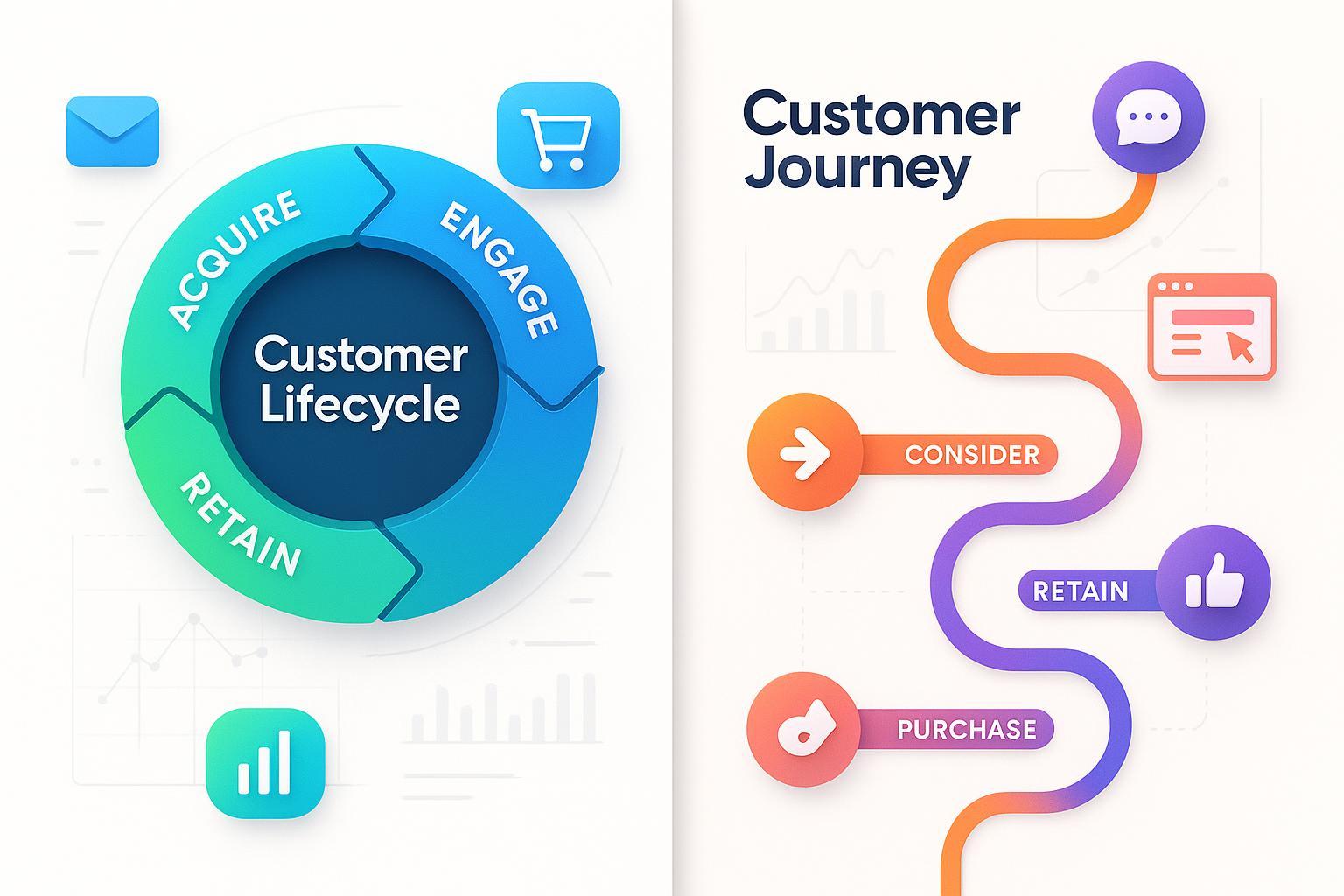Customer Lifecycle vs Customer Journey: Key Differences and Strategic Implications for E-commerce in 2025

In today’s rapidly evolving e-commerce landscape, successful brands don’t just acquire customers—they nurture them, predict their needs, and guide them along personalized experiences that maximize value. Yet, confusion still reigns over two foundational marketing concepts: the Customer Lifecycle and the Customer Journey. Are they the same? How do they differ? And—critically—how can understanding both unlock real growth when applied with modern analytics and attribution tools like Attribuly?
This guide breaks down the key differences, overlapping strategies, and practical implications of these frameworks, all through a 2025 lens tailored for Shopify brands and data-driven marketers.
Understanding the Fundamentals: Customer Lifecycle vs Customer Journey
What Is the Customer Lifecycle?
- Definition: The customer lifecycle maps the evolving relationship between a brand and its customers, extending from initial awareness, through onboarding, retention, loyalty, and—when necessary—win-back or reactivation.
- Focus: Relationship-driven, high-level roadmap, prioritizing stages where the brand should act to deliver relevant value and maximize Customer Lifetime Value (CLV).
- 2025 Framework (Typical Stages):
- Acquire (Awareness)
- Onboard/Engage
- Retain/Grow
- Cherish/Advocate (Loyalty)
- Reactivate/Win-back
- Modern Twist: Today, micro-segmentation via AI and real-time analytics enables brands to automate messaging, retargeting, and offers at every touchpoint—not just the "big" stages (Bloomreach, CleverTap).
What Is the Customer Journey?
- Definition: The customer journey charts the non-linear, often multi-channel experiences a shopper navigates as they discover, consider, purchase, and become loyal to a brand. It zooms in on the “how”—the sequence and nature of actual interactions.
- Focus: Customer-centric, path-driven, dynamic—the goal is to map and optimize every possible route a buyer might take, across devices and platforms.
- 2025 Framework (Typical Stages):
- Awareness
- Consideration
- Purchase
- Post-purchase/Experience
- Loyalty/Advocacy
- Modern Twist: The journey is no longer a straight line—retargeting, multi-touch ad exposures, and “micro-moments” (e.g., seeing a friend’s Instagram post, reading a review, engaging with live chat) are woven together via platforms like Shopify and Attribuly (Shopify).
Side-by-Side Comparison Table
| Customer Lifecycle | Customer Journey | |
|---|---|---|
| Viewpoint | Brand-driven, stage-focused | Customer-driven, interaction-focused |
| Purpose | Maximize retention, CLV, and value at each stage | Optimize experience across all touchpoints |
| Nature | Linear/cyclical (macro stages) | Non-linear, personalized, micro-level paths |
| Analytics Role | Segmentation, automation, lifecycle scoring | Path analysis, attribution, moment mapping |
| Key Tools | RFM models, CRM, lifecycle automation | Journey analytics, multi-touch attribution |
Real-World Applications in E-commerce & Shopify
Lifecycle in Action
- Targeted Retention: Brands segment users by Recency, Frequency, and Monetary value (RFM) to tailor post-purchase emails, win-back offers, and loyalty rewards—driving up to 95% profit increases with just a 5% bump in retention (CleverTap).
- Personalized Onboarding: Automated onboarding sequences for new Shopify subscribers reduce churn and spark repeat purchases (see: 56%+ repeat buyers in beauty DTC with personalized journeys, Shopify).
- International/Segmented Lifecycle: Global brands adapt stages and messaging for geo/language/currency segments using tools like Attribuly’s segmentation + Shopify’s automation workflows.
Journey in Action
- Path Optimization: Shopify stores use journey analytics (via Attribuly or GA4) to uncover which touchpoints—TikTok, Meta ads, influencer DMs—truly drive conversions, reallocating budget based on ROI.
- Experience Mapping: By mapping pain points (e.g., cart abandonment, slow checkout), brands deploy contextual popups or chatbots at the exact micro-moment to save the sale.
- Omnichannel Blending: 59%+ of shoppers research online, buy offline or vice versa—platforms now unify all digital + physical interactions for a seamless journey (Shopify).
Where They Overlap: Unifying for Maximum Impact
- Journey data feeds lifecycle segmentation (e.g., mapping high-intent paths to "loyalist" lifecycle buckets).
- Lifecycle triggers (churn risk, recent purchase, etc.) activate specific journey automations (targeting, retargeting, personalized content).
- Advanced analytics tools like Attribuly help bridge both worlds by tracking, attributing, and automating responses to cross-channel touchpoints in real time.
How Modern Analytics & Attribution Platforms (Like Attribuly) Bring It Together
Attribuly: The Analytics Engine for Lifecycle and Journey
Attribuly is engineered for Shopify, DTC, and growth-focused e-commerce brands who want truly actionable insights—across both lifecycle and journey. Here’s how:
1. Multi-Touch Attribution for Full Journey Visibility
Attribuly uses server-side, privacy-compliant tracking to map every click, impression, and action—even from anonymous visitors. It goes beyond “last click” or simplistic models, supporting:
- Linear, U-shaped, time-decay, and custom attribution models
- Attribution mapped to both lifecycle and journey stages for granular ROI clarity (Blueshift).
2. Segmentation & Automated Retargeting
Segmenting by lifecycle stage (e.g., new vs. at-risk vs. VIP) or journey event (e.g., "abandoned checkout," "product page view,") is seamless. Attribuly syncs directly with:
- Shopify
- Klaviyo, Omnisend, CRM
- TikTok/Meta/Bing/Google for cross-channel ad retargeting
This means, for example, you can trigger a win-back offer only to users who dropped off after a second purchase—an advanced, real-world combination of journey and lifecycle logic.
3. Shopify-Centric and AI-Powered
- One-click Shopify install; no code required
- Enriched first-party/zero-party data capture (critical post-cookie)
- AI assistant for journey analysis, churn prediction, and offer personalization
- Full compliance with GDPR/CCPA; supports cookieless attribution
4. Actionable Analytics, Not Just Reports
- Visual dashboards show revenue by stage and journey path—helping teams optimize the flows that matter most.
- Automated triggers (email, audience sync, popups) can be powered by a blend of journey and lifecycle insights—no technical barrier for DTC brands.
(See: Typical outcomes include ROAS boosts of 20%+, repeat purchase rates up to 56%, and doubled subscriber growth in Shopify stores leveraging journey-centric automation [source].)
Deep-Dive: Scenario-Based Application & Before/After Case Studies
Scenario 1: Subscription Brand (Shopify)
- Before: Generic onboarding emails, 1-in-6 trial users convert to paid, high churn.
- After integrating Attribuly analytics:
- Onboarding, engagement, reward, and renewal stages automated
- Email/sms/ads targeted by journey trigger & lifecycle risk
- Result: Conversion up 135% (Aje’s experience via similar Shopify/Attribuly workflows [Shopify])
Scenario 2: Churned Customer Win-back
- Workflow: RFM and journey data identify high-LTV churned users; automated win-back offers sent based on most recent touchpoint.
- Result: Case studies suggest up to 800% email sign-up lift and 1% conversion jump post-automation (SkinnyMe Tea, Shopify).
Scenario 3: International DTC Brand
- Workflow: Local stages, geo-specific journeys via Shopify + Attribuly segmentation and localized email/ads; higher retention and LTV in global segments.
Scenario 4: Attribution Model Optimization
- Use: Attribuly’s dashboard runs A/B tests on multi-touch models, revealing the best-performing journey segments—used to reallocate campaign budget.
Practical Playbook: How to Operationalize Lifecycle & Journey (2025)
- Map Your Lifecycle and Journey
- Use Attribuly (or similar) to segment both by lifecycle stage AND journey event-data
- Integrate Cross-Channel Tracking
- Install server-side tracking (vital for post-cookie, privacy-first marketing)
- Automate Action by Segment & Touchpoint
- Leverage AI for real-time offers, retargeting, and predictive segmentation
- Unify Data for Clear Attribution
- Link campaign, CRM, and journey analytics (Attribuly + Shopify + Klaviyo/GA4)
- Continuously Test and Optimize
- Schedule regular reviews of ROI by journey path and lifecycle bucket
- Prioritize Privacy, First-Party Data, and Consent
Pro Tip: Platforms like Attribuly power all of the above—from automated tracking to dynamic report visualization—out of the box. This not only future-proofs your marketing as privacy rules shift, but maximizes every dollar in your Shopify ad/retention budget.
2025 Strategic Recommendations
- Don’t Choose—Bridge Both: Real growth comes from blending lifecycle segmentation with granular journey mapping. Use lifecycle for high-level targeting, journey for micro-optimizations.
- Automate and Personalize: Invest in tools that enable server-side tracking, real-time segmentation, and multi-touch attribution across all channels.
- Align Teams Around the Customer, Not Just Campaigns: Ensure marketing, product, and support teams see unified data—breaking down silos.
- Continuously Optimize: Let analytics (Attribution + AI) guide ongoing investment, not just one-off campaigns.
- Stay Privacy-Forward: Use platforms ready for a cookieless, consent-driven digital world.
Conclusion & Next Steps
By mastering both the Customer Lifecycle and Customer Journey—and deploying the right analytics tools—Shopify and DTC brands can deliver truly relevant experiences at scale, driving growth, loyalty, and profitability in 2025 and beyond.
Ready to operationalize these strategies? Try Attribuly’s e-commerce analytics and attribution capabilities today to get the clearest picture of your buyers and campaigns—no code required.
